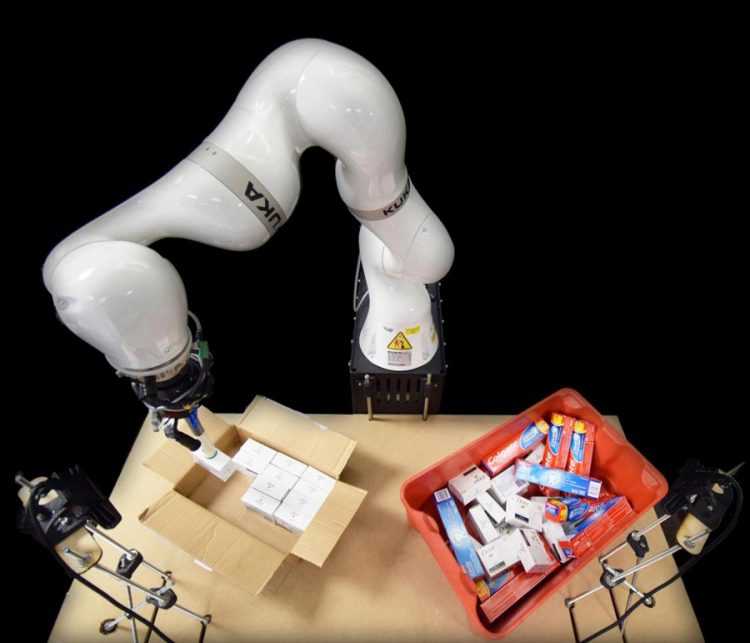Artificial intelligence controls robotic arm to pack boxes and cut costs

An automation workspace with a Kuka robotic arm and a bin containing a pile of objects that need to be tightly packed into a shipping order box. The Rutgers robotic packing system is designed to overcome errors during packing. Credit: Rahul Shome/Rutgers University-New Brunswick
Rutgers computer scientists used artificial intelligence to control a robotic arm that provides a more efficient way to pack boxes, saving businesses time and money.
“We can achieve low-cost, automated solutions that are easily deployable. The key is to make minimal but effective hardware choices and focus on robust algorithms and software,” said the study's senior author Kostas Bekris, an associate professor in the Department of Computer Science in the School of Arts and Sciences at Rutgers University-New Brunswick.
Bekris, Abdeslam Boularias and Jingjin Yu, both assistant professors of computer science, formed a team to deal with multiple aspects of the robot packing problem in an integrated way through hardware, 3D perception and robust motion.
The scientists' peer-reviewed study was published recently at the IEEE International Conference on Robotics and Automation, where it was a finalist for the Best Paper Award in Automation. The study coincides with the growing trend of deploying robots to perform logistics, retail and warehouse tasks. Advances in robotics are accelerating at an unprecedented pace due to machine learning algorithms that allow for continuous experiments.
This YouTube video shows a Kuka robotic arm tightly packing objects from a bin into a shipping order box (five times actual speed).
Tightly packing products picked from an unorganized pile remains largely a manual task, even though it is critical to warehouse efficiency. Automating such tasks is important for companies' competitiveness and allows people to focus on less menial and physically taxing work, according to the Rutgers scientific team.
The Rutgers study focused on placing objects from a bin into a small shipping box and tightly arranging them. This is a more difficult task for a robot compared with just picking up an object and dropping it into a box.
The researchers developed software and algorithms for their robotic arm. They used visual data and a simple suction cup, which doubles as a finger for pushing objects. The resulting system can topple objects to get a desirable surface for grabbing them. Furthermore, it uses sensor data to pull objects toward a targeted area and push objects together. During these operations, it uses real-time monitoring to detect and avoid potential failures.
Since the study focused on packing cube-shaped objects, a next step would be to explore packing objects of different shapes and sizes. Another step would be to explore automatic learning by the robotic system after it's given a specific task.
###
The lead authors are Rahul Shome and Wei N. Tang, doctoral students in the Department of Computer Science. Co-authors included doctoral students Changkyu Song and Chaitanya Mitash, as well as Hristiyan Kourtev, a scientific programmer at the Rutgers Center for Cognitive Science. The work was supported by research contracts and grants from JD.com's Silicon Valley research center and the National Science Foundation.
Media Contact
All latest news from the category: Information Technology
Here you can find a summary of innovations in the fields of information and data processing and up-to-date developments on IT equipment and hardware.
This area covers topics such as IT services, IT architectures, IT management and telecommunications.
Newest articles

A new puzzle piece for string theory research
Dr. Ksenia Fedosova from the Cluster of Excellence Mathematics Münster, along with an international research team, has proven a conjecture in string theory that physicists had proposed regarding certain equations….

Climate change can cause stress in herring larvae
The occurrence of multiple stressors undermines the acclimatisation strategies of juvenile herring: If larvae are exposed to several stress factors at the same time, their ability to respond to these…

Making high-yielding rice affordable and sustainable
Plant biologists show how two genes work together to trigger embryo formation in rice. Rice is a staple food crop for more than half the world’s population, but most farmers…



